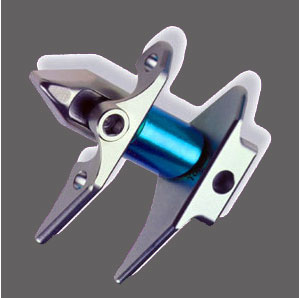
X-Stop for spinal stenosis is an implant device used during the Interspinous Process Decompression Procedure. X-Stop offers a less invasive surgical solution for particular types of lumbar spinal stenosis and can provide good results for many patients. X-Stop is manufactured by Medtronic and has been successfully used to treat specific forms of lumbar spinal stenosis in The United States for over 10 years. Since the procedure is minimally invasive and can provide lasting relief, we find it worth investigating for all patients with moderate to severe spinal stenosis symptoms and indicated parameters for treatment.
This essay profiles the X-Stop device and the surgical technique used to implant it. We will explore the many benefits to X-Stop treatment, the downsides of the product and the alternative therapeutic paths that might be considered instead of X-Stop.
X-Stop for Spinal Stenosis Indications
X-Stop is only indicated for a select patient population. Patients must demonstrate specific criteria in order to be considered as a prospective X-Stop recipient. The patient must be over the age of 50 and diagnosed with single or double adjacent level lumbar spinal stenosis. The patient must express neurological symptoms in the legs, consistent with true spinally-motivated sciatica. Patients should report relief from their pain when bending forward at the waist, as this increases the effective diameter of the central spinal canal and will help predict a positive outcome for X-Stop patients postoperatively. Patients should have attempted conservative care for at last 6 months prior to preparing for surgery.
Patients must not demonstrate contraindicating conditions, such as generally poor health, spondylolisthesis, low bone density, lumbar vertebral fracture, past lumbar surgery or lumbar scoliosis. Patients should generally be expected to benefit in terms of pain relief and improved physical functionality before undergoing the surgical technique of Interspinous Process Decompression.
We would add a strong and often overlooked caution to the above indications: Many patients are misdiagnosed as suffering from symptomatic spinal stenosis, when the extent of stenosis is normal and is not the underlying pain-generating mechanism. When the stenosis is misdiagnosed as the source of suffering, any treatment seeking to correct it will virtually always fail to bring about lasting or complete relief. Therefore, patients who are considering surgery should be 100% percent positive that their diagnoses are sound and accurate before undergoing the operation.
X-Stop IPD Surgery
The procedure for placing the X-Stop device is simple, straight forward and minimally invasive. A small incision is made at the operated level of the spine. The surgeon creates a space in between the spinous processes of the stenotic level and simply places the device to be held in place organically by the natural anatomy of the spine, combined with the engineering of the product design. Use of fluoroscopy improves implant placement and also helps the physician to be sure that the stenosis is stable and unchanged before actually placing the device. The procedure can be performed under local anesthetic or general anesthetic, depending on several case-specific criteria.
Once positioned properly, the incision is closed and the patients will be able to stand, walk and do many normal physical tasks immediately. Most patients will be told to rest and not perform any strenuous activity for 2 weeks to 2 months after surgery. Some patients will be provided physical therapy, often to overcome the many collateral deficits of years of stenosis, more than to rectify damage caused by the procedure itself.
Since the procedure does not disturb the most sensitive structures of the spine or require muscular dissection, the recovery period is generally short and only mildly painful for most patients. This minimizes the need for powerful pain medications and also reduces the chances for the more serious complications that are often associated with more invasive forms of spinal surgery, such as laminectomy. It should be noted that laminectomy is the gold standard for lumbar stenosis care and is the usual recommended treatment for patients who require surgery and do not elect, or are not qualified, to receive X-Stop.
X-Stop for Spinal Stenosis Outcomes
X-Stop provides good postoperative results for most patients with ideal indications for treatment. The Interspinous Process Decompression technique spares the patient from more damaging forms of spinal surgery, including laminectomy, corpectomy and spinal fusion. This is an extremely positive benefit of the X-Stop device, since these operations are risky and do real damage to the vertebral column. If the X-Stop does not work well for the patient, then they can still follow a more advanced and invasive surgical path in the future.
Complications reported from X-Stop patients usually center around implant slippage or migration. This condition usually entails either the removal of the device or its repositioning back in the correct anatomical location via a secondary surgery. Some patients report chronic pain from the device or functional deficits in particular ranges of movement beyond what the device is supposed to limit. Some of these conditions can be overcome with physical therapy or the simple passage of time, while others might necessitate device removal and reevaluation of the treatment plan. Infection, implant rejection or other anatomical reaction taint the effectiveness of the X-Stop in some patients. In most cases, these scenarios will require the device to be permanently removed.
Many patients demonstrate ideal device placement and seem to be classic surgical successes. However, they still report stenosis-related pain that is identical or even worse than they suffered prior to the procedure. In virtually all cases, this is indicative of misdiagnosis of the stenosis as the true cause of pain from the beginning. This is why we caution all patients who are considering X-Stop, or any surgical endeavor, to carefully evaluate their diagnosis with several care providers prior to undergoing the operation. After all, stenosis is still one of the greatest scapegoats for pain being blamed on completely normal and expected spinal aging in the entire back and neck pain treatment sector of medicine.
Spinal Stenosis > Spinal Stenosis Surgery > X-Stop for Spinal Stenosis





